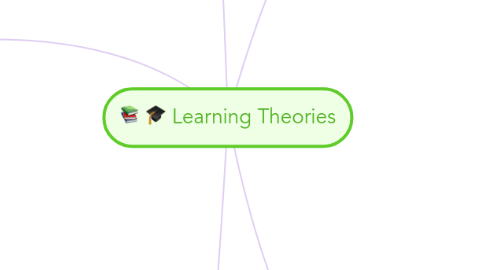
1. Constructivism
1.1. Principles
1.1.1. Learning through interaction with environment
1.1.2. Begin with complex problems, break down problem with smaller solutions (problem solving skills)
1.1.3. Vygotsky's Zone of Proximal Development
1.1.4. Teacher as facilitator
1.1.5. Problem & Project based learning
1.1.6. Discovery Learning
1.1.7. Collaborative Learning and Active Learning
1.2. Implications
1.2.1. Teacher presents problem, students solve it
1.2.2. "Learning by Making"
1.2.3. Real life application situation
1.2.4. Write stories or essays and correct as you go along
1.3. Connections
1.3.1. Gizmos
2. TPACK
2.1. Principles
2.1.1. TPACK is an acronym for Technology, Pedagogy, And Content Knowledge. It is a guideline to highlight some of the important fields of knowledge a teacher should have to become successful. The three main categories of knowledge involved in this theory which can stand alone or work together are Technology, Pedagogy and Content.
2.1.1.1. T is for Technology Knowledge which is simply how comfortable an individual is with the use of incorporating technology into the classroom with the ultimate goal of enhancing learning.
2.1.1.2. P is for Pedagogical Knowledge which can be defined as the knowledge an educator is familiar with in regards to how children learn.
2.1.1.3. C is for Content Knowledge and is how much the teacher knows in regards to the subject they are teaching.
2.1.1.4. PC represents Pedagogical Content knowledge and how the educator is able to apply both knowledge concepts together and effectively.
2.1.1.5. TC is the manner in which technology is tied incorporated into the content. The application of technology to teach new content.
2.1.1.6. TP stands for technology and pedagogical knowledge. Its application is the process in which you take your knowledge about children's learning patterns, and incorporate various technologies that benefit the lesson.
2.1.1.7. TPC is the combination of all three branches of knowledge from TPACK. The integration and connections between the three types of knowledge allow for optimal teaching and learning.
2.2. Implications
2.2.1. Understanding the relationship between various types of knowledge in order to create and present the best lessons possible.
2.2.2. Focus on all aspects in a manner that benefits you and your students best
2.2.3. Understand the relationship between all branches of TPACK
2.2.4. Digital Animation to simplify concepts
2.2.5. Familiarizing yourself with a wide variety of focus points
2.3. Connections
2.3.1. This entire course has given us a stronger technology background that will enhance our abilities within the classroom.
2.3.2. Gizmos
2.3.3. Reading Eggs
3. Connectivism
3.1. Principles
3.1.1. Learning is the process of networking through making connections
3.1.2. A learning theory for the digital ages
3.1.3. “… forget about trying to “know” everything; instead build your network of knowledge sources, and access them when ever you need them” -Ryan Tracey
3.1.4. The capacity to know more, is more critical than what is currently known
3.1.5. Emphasis on the abilitly to make connections
3.1.6. Maintaining connections leads to lifelong learning
3.1.7. Its more important to “know-where” to find things in your network than to “knowhow” or “know what” -George Simens
3.1.8. Network is the learning
3.2. Implications
3.2.1. Build Networks
3.2.2. Teach students how to use modern day technology
3.2.3. Save good grammar sites and know how to use them
3.3. Connections
3.3.1. Twitter
3.3.2. All modern technology
3.3.3. Search engines
3.3.4. Communication tools
4. Behaviourism
4.1. Principles
4.1.1. Environmental Stimulus + Blank Slate = Learning
4.1.2. Stimulus Response, Repitition
4.1.3. Classical Conditioning - Pavolv's dog (salivated when bell rang)
4.1.4. Operant Conditioning - Positive and Negative Reinforcement (Adding and taking away)
4.1.5. Practice Makes Perfect
4.1.6. Direct Instruction (Lectures)
4.2. Implications
4.2.1. Emphasize Performance and Practice
4.2.2. Observable and Measurable Learning Outcomes
4.2.3. Reinforce accomplishments with feedback
4.2.4. Teacher gives answer, students copy teacher and practice continually
4.2.5. Worksheets
4.3. Connections
4.3.1. There are many technology based products which are suitable for the Behaviourism Theory such as : videos, drill and practice websites, iclickers which are used by teachers as a direct feedback tool, and quizzing websites
5. Information Processing (Cognitivism)
5.1. Principles
5.1.1. Learning is Active, Not Passive
5.1.2. Learning does not happen through lecture or through watching (responses to Behaviourism)
5.1.3. Learning is not directly observable, it is an active mental process of acquiring, remembering and using knowledge
5.1.4. Change in knowledge = change in behaviour
5.1.5. Mind is like a computer
5.1.6. Cognitive Load Theory - people learn better when they build on what they already know
5.1.6.1. - we build schemas in WM and integrate them into existing schemas in long term memory
5.1.6.2. - Schemas from LTM into STM to understand world
5.1.6.3. - Experts in a domain have constructed large schemas and networks of knowledge
5.1.7. Connect to prior knowledge, then make connections
5.2. Implications
5.2.1. Practice for Retention
5.2.2. Mneumonic devices
5.2.3. Chunking
5.2.4. Mind Maps/ Concept Maps
5.2.5. Connect to prior knowledge, then make connections and show "how'' it works
5.2.6. Practice in context
5.3. Connections
5.3.1. Electronic Note Taking
5.3.2. Presentation Tools
